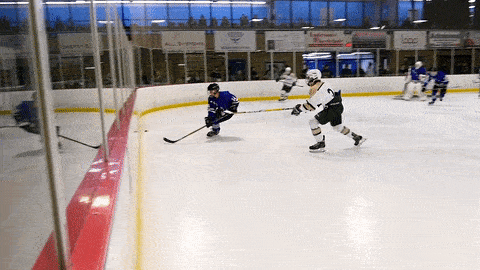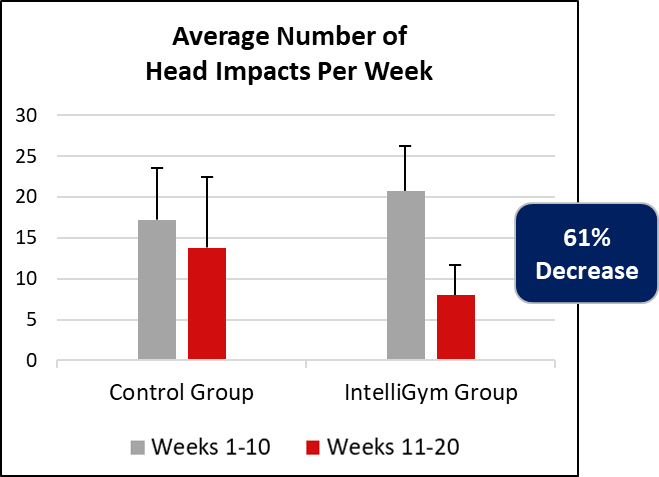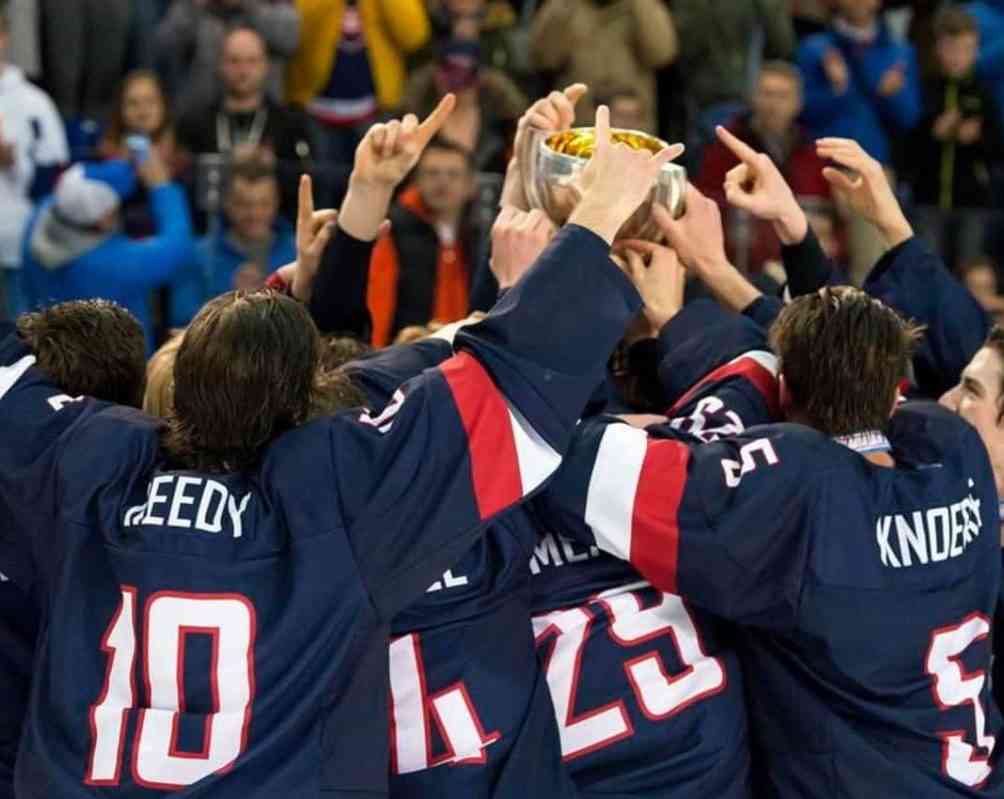Concussion Study Indicates IntelliGym Training Could Reduce Chance of Injury
Concussion Study Indicates IntelliGym Training Could Reduce Chance of Injury
Unanticipated Hits Are the Leading Cause of Injury. Can IntelliGym Training Help?
Hockey is a fast sport. At a certain age, it becomes a hard-hitting sport. As players get bigger and stronger, the risk of injury gets bigger too. It’s no secret that concussions and other injuries have become top-of-mind for athletes, parents, and coaches across all ages and skill levels. Sports like hockey come with a degree of risk attached to them. Generally speaking, however, the health benefits – both physical and mental – far outweigh the risks. That doesn’t mean we shouldn’t be talking about ways to protect athletes and prevent injuries.
Professional, amateur, and youth leagues across the world are adopting new injury protocols and technologies designed to protect athletes from injury. We’re thrilled to see the industry respond to pressure from various stakeholders. We’re also aware of the reality that you can’t remove every threat from the sport while still maintaining its integrity. However, there’s more that can be done to protect athletes while keeping the game intact, and research points to cognitive training as a potential way to reduce injuries.
“We know from the epidemiology of the concussion that some of the most concerning mechanisms are the unanticipated hits.”
Dr. Michael Stuart
Mayo Clinic Center for Sports Medicine
Most research agrees that the leading cause of injuries and concussions in hockey are unanticipated hits. We’ve seen evidence that training with the Hockey IntelliGym cognitive training program, which is built to improve performance on the ice, also helps to reduce unanticipated hits. In a fast-paced sport like hockey, the ability to be more aware of your surroundings while anticipating the play of your teammates and opponents is critical to winning, but can it help you avoid injury too? The Concussion Research Lab at the University of Delaware wanted to find out.
Concussion Lab Study Shows IntelliGym Training Reduces Head Impacts
An independent study conducted by researchers at the Concussion Research Lab at the University of Delaware put the IntelliGym to the test with two midget-aged hockey teams. The study was aimed at determining the effects of the Hockey IntelliGym in reducing head impacts. Thomas A. Buckley, Director of the Concussions Research Lab, led the study and presented the results at the Ice Hockey Concussion Summit, organized by the Mayo Clinic Center for Sports Medicine, a cutting-edge sports performance and training clinic with a focus on injury prevention.
For 10 weeks, half the players trained twice per week, 30-minutes per session, with the IntelliGym computer-based training program while the other half reviewed and evaluated hockey videos for the same duration. The players were outfitted with high-end accelerometers to measure head impact kinematics, looking at a number of factors to determine the number and magnitude of head impacts, with measurements for both groups taken both before and after the training. The results were impressive, to say the least. The group of athletes who participated in the IntelliGym training showed a significant reduction in the number and magnitude of head impacts during the second half of the season.
“After 10 weeks of the computerized cognitive training using IntelliGym, those players suffered about half as many head impacts as they did before the training.”
Dr. Thomas Buckley
Director, Concussion Research Lab, University of Delaware

Notice how the player receiving the hit turns their head to see their opponent right before the check occurs. The more aware a player is, the more they can anticipate incoming hits, the less vulnerable they will be to unanticipated hits.

Data from Dr. Buckley’s study shows a 61% reduction in the average number of head impacts for the IntelliGym group during weeks 11-20, following 10 weeks of IntelliGym training.
As on-ice training continues during a season, you would expect to see a slight decrease in the number of head impacts over the course of the season. However, the control group did not see a significant reduction. There was also not a significant difference in the number of head impacts between the two groups during weeks 1-10, but the IntelliGym group saw an average 61% reduction in head impacts.
While it’s easy to be skeptical of such incredible results, they point towards cognitive training as an effective prevention strategy, and further research should be done to study the effects of increasing anticipation and awareness through sports intelligence training in reducing on-ice injuries and concussions. In the meantime though, it doesn’t hurt to see for yourself what cognitive training can do for you.
Data from Dr. Buckley’s study shows a 61% reduction in the average number of head impacts for the IntelliGym group during weeks 11-20, following 10 weeks of IntelliGym training.

Medical Data Supports Reduction in Injuries and Head Injuries
After learning about the potential effects of cognitive training on injury reduction, IntelliGym wanted to go deeper to see if they could find more evidence to support this hypothesis. Jacob Greenshpan, Ph.D. and Research Director for IntelliGym, analyzed medical data from USA Hockey before and after the National Team Development Program (NTDP) started implementing the Hockey IntelliGym into their training routine in the 2009 season. Click here to read that story, about how the USA Hockey NTDP U17 and U18 athlete’s increased their points-per-game by 42% within one season. Dr. Greenshpan compared pre-training data from 2007 to 2009 to post-training data in 2010 and 2011 to see what he could find.
Greenshpan found a significant reduction in the number of injury-related visits to the doctor, hockey-related injuries, and total head injuries in the 2 years following integration of the IntelliGym into the NTDP. This data was presented at the IIHF International Youth Coaching Symposium during the 2013 IIHF Ice Hockey World Championship in Helsinki, Finland. The IntelliGym is still the official cognitive trainer of the USA Hockey NTDP to this day.
While less “scientific” than Dr. Buckley’s study, described above, the numbers tell an interesting story that should not be ignored or taken lightly when talking about injuries in youth hockey. We all share the same goal – to provide a safe and fun environment for young athletes to play hockey. If cognitive training, not just the IntelliGym, can help achieve this goal, we should all be talking a little bit more about the topic.

Click here to read the story about how the USA Hockey NTDP U17 and U18 team increased their win percentage while athletes increased their points-per-game by an average of 42% after integrating the IntelliGym into their training routine in 2009.
Promising Results Indicate Cognitive Training Can Help Reduce Injury. What Are You Waiting For?
These results point toward cognitive training as a potential way to reduce head impacts and injuries in youth hockey players. To confirm the results, the study needs to be repeated with more players. Nonetheless, the results are a promising step toward reducing the risk of head impacts in ice hockey. It makes sense that if cognitive training, including the Hockey IntelliGym training program, can improve an athlete’s anticipation and awareness, that they are likely to receive fewer unanticipated hits as a result. A training program with the potential to improve performance and reduce the chance of injury is one that athletes, parents, and coaches everywhere should be using.
With everything that we continue to learn about concussions, including the effect of the number of head impacts sustained over a career rather than just the magnitude of impact, it is important to explore alternatives that can make the game of hockey a little bit safer while retaining its integrity as a hard-hitting, fast-paced sport. Saving even a few more youth from short-term injury or long-term consequences as a result of playing the sport that they love is something we should always be striving for.
“If you’re more aware of your surroundings, you’re going to be able to move the puck faster, and be able to absorb contact, but also to avoid contact. If you can just reduce the number of contacts a player absorbs, that’s a great starting point.”
Sean Goldsworthy
Head Coach, Minnetonka High School Skippers, 2018 State Champs

